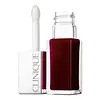What's inside
What's inside
 Key Ingredients
Key Ingredients

 Benefits
Benefits

 Concerns
Concerns

 Ingredients Side-by-side
Ingredients Side-by-side

Hydrogenated Polyisobutene
EmollientTriisostearyl Citrate
EmollientPentaerythrityl Tetraethylhexanoate
EmollientPolyglyceryl-2 Triisostearate
EmulsifyingHydrogenated Polydecene
EmollientRicinus Communis Seed Oil
MaskingDipentaerythrityl Tri-Polyhydroxystearate
EmollientCarthamus Tinctorius Seed Oil
MaskingOlea Europaea Fruit Oil
MaskingSimmondsia Chinensis Seed Oil
EmollientSilica
AbrasiveTocopheryl Acetate
AntioxidantCurcuma Longa Root Extract
MaskingGlycine Soja Seed Extract
Skin ConditioningCeramide Ns
Skin ConditioningSqualane
EmollientLactobacillus Ferment
Skin ConditioningHelianthus Annuus Seed Oil
EmollientLauryl PCA
HumectantCaprylyl Glycol
EmollientDimethicone
EmollientPolysilicone-11
Water
Skin ConditioningTetrahexyldecyl Ascorbate
AntioxidantPentaerythrityl Tetra-Di-T-Butyl Hydroxyhydrocinnamate
AntioxidantMica
Cosmetic ColorantCI 77491
Cosmetic ColorantCI 77492
Cosmetic ColorantCI 77499
Cosmetic ColorantCI 45410
Cosmetic ColorantCI 17200
Cosmetic ColorantCI 77891
Cosmetic ColorantCI 77742
Cosmetic ColorantCI 19140
Cosmetic ColorantCI 45380
Cosmetic ColorantCI 73360
Cosmetic ColorantCI 75470
Cosmetic ColorantCI 77163
Cosmetic ColorantCI 15850
Cosmetic ColorantCI 45370
Cosmetic ColorantCI 42090
Cosmetic ColorantCI 15985
Cosmetic ColorantHydrogenated Polyisobutene, Triisostearyl Citrate, Pentaerythrityl Tetraethylhexanoate, Polyglyceryl-2 Triisostearate, Hydrogenated Polydecene, Ricinus Communis Seed Oil, Dipentaerythrityl Tri-Polyhydroxystearate, Carthamus Tinctorius Seed Oil, Olea Europaea Fruit Oil, Simmondsia Chinensis Seed Oil, Silica, Tocopheryl Acetate, Curcuma Longa Root Extract, Glycine Soja Seed Extract, Ceramide Ns, Squalane, Lactobacillus Ferment, Helianthus Annuus Seed Oil, Lauryl PCA, Caprylyl Glycol, Dimethicone, Polysilicone-11, Water, Tetrahexyldecyl Ascorbate, Pentaerythrityl Tetra-Di-T-Butyl Hydroxyhydrocinnamate, Mica, CI 77491, CI 77492, CI 77499, CI 45410, CI 17200, CI 77891, CI 77742, CI 19140, CI 45380, CI 73360, CI 75470, CI 77163, CI 15850, CI 45370, CI 42090, CI 15985
Polyglyceryl-2 Isostearate/Dimer Dilinoleate Copolymer
EmollientDilinoleic Acid/Propanediol Copolymer
EmollientSimmondsia Chinensis Seed Oil
EmollientCorylus Avellana Seed Oil
EmollientHelianthus Annuus Seed Oil
EmollientParfum
MaskingVanillin
MaskingTocopheryl Acetate
AntioxidantAmmonium Glycyrrhizate
MaskingLithospermum Erythrorhizon Root Extract
Skin ConditioningGlycine Soja Oil
EmollientDiisostearyl Malate
EmollientCI 42090
Cosmetic ColorantBixa Orellana Seed Oil
EmollientTocopherol
AntioxidantPolyglyceryl-2 Isostearate/Dimer Dilinoleate Copolymer, Dilinoleic Acid/Propanediol Copolymer, Simmondsia Chinensis Seed Oil, Corylus Avellana Seed Oil, Helianthus Annuus Seed Oil, Parfum, Vanillin, Tocopheryl Acetate, Ammonium Glycyrrhizate, Lithospermum Erythrorhizon Root Extract, Glycine Soja Oil, Diisostearyl Malate, CI 42090, Bixa Orellana Seed Oil, Tocopherol
 Reviews
Reviews

Ingredients Explained
These ingredients are found in both products.
Ingredients higher up in an ingredient list are typically present in a larger amount.
Ci 42090 is a synthetic dye created from petroleum. It is used to give a bright blue color to cosmetics, medicine, and food.
Helianthus Annuus Seed Oil is the oil derived from the seeds of a Sunflower. Sunflower seed oil is non-fragrant. It is an emollient, meaning it helps to soften the skin.
Sunflower seed oil contains many fatty acids. The fatty acids found in sunflower seeds include (from highest amount to least): linoleic acid, myristic acid, palmitic acid, stearic acid, arachidic acid, oleic acid, and linolenic acid.
These fatty acids help the skin create ceramides. Ceramides play a role in repairing the skin barrier.
Helianthus Annuus Seed Oil helps moisturize the skin. This in turn helps the skin look more rejuvenated and smoother.
Sunflowers are rich in vitamin E.
Historians believe Indigenous cultures of North America domesticated sunflowers before corn. Thus they relied on sunflower oil for a variety of uses. One such use is moisturizing skin and hair.
Sunflower seed oil may not be fungal acne safe. We recommend speaking with a professional if you have any concerns.
Learn more about Helianthus Annuus Seed OilThis oil comes from the seeds of the desert shrub called Jojoba. It is more commonly known as jojoba oil, a non-comedogenic oil.
Jojoba oil does not contain fragrance and has many fatty-acids, making it a great soothing ingredient.
It also contains Vitamin E, a great moisturizing ingredient. Vitamin E is also an antioxidant and protects your skin against oxidative damage.
This ingredient humectant properties, meaning it helps draw moisture from the air. This helps keep your skin hydrated.
While jojoba has antibacterial properties, it is only able to kill some strains of bacteria.
Studies also show it helps in wound healing. In fact, Indigenous cultures have used jojoba as a moisturizer and to help treat burns for centuries.
Fun fact: Jojoba oil similar to natural human skin sebum, so it has a great effect on dry skin. It is also promising with helping to regulate sebum production.
Due to its fatty acid content, Jojoba oil may not be fungal acne safe. We recommend speaking with a professional if you have any concerns.
Learn more about Simmondsia Chinensis Seed OilTocopheryl Acetate is AKA Vitamin E. It is an antioxidant and protects your skin from free radicals. Free radicals damage the skin by breaking down collagen.
One study found using Tocopheryl Acetate with Vitamin C decreased the number of sunburned cells.
Tocopheryl Acetate is commonly found in both skincare and dietary supplements.
Learn more about Tocopheryl Acetate